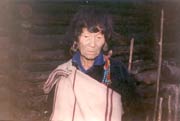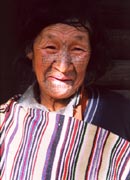| Outdated face tattoo
 Tattoo was called "Diao Ti", "Qing Ji", "Qing Mian", "Xiu Jiao", "Xiu Mian", "Ci Mo" and "Zha Qing" in ancient China. It is to use such sharp tools as thorn, needle or knife to carve and colour patterns or signs in the skin, which are unfading and life-long decoration on the body. It appeared quite early, evolved from the primitives' custom of painting on the body as decoration or in religious ceremonies. Once, it was widely popular with many primitive nations in African, Oceania, Southeast Asian, and Central and South America. Even today, some aboriginals still consider it an indispensable decoration and the entire nation love it whole-heartedly. In the southeast and the southwest of ancient China, tattoo was very popular, too. Until recently, remnants of the custom have remained in such minority groups as Li, Dai, Bulang, De'ang, Dulong, Jinuo, Wa, Nu, Jingpo, Luoba, Gaoshan, etc. Tattoo was called "Diao Ti", "Qing Ji", "Qing Mian", "Xiu Jiao", "Xiu Mian", "Ci Mo" and "Zha Qing" in ancient China. It is to use such sharp tools as thorn, needle or knife to carve and colour patterns or signs in the skin, which are unfading and life-long decoration on the body. It appeared quite early, evolved from the primitives' custom of painting on the body as decoration or in religious ceremonies. Once, it was widely popular with many primitive nations in African, Oceania, Southeast Asian, and Central and South America. Even today, some aboriginals still consider it an indispensable decoration and the entire nation love it whole-heartedly. In the southeast and the southwest of ancient China, tattoo was very popular, too. Until recently, remnants of the custom have remained in such minority groups as Li, Dai, Bulang, De'ang, Dulong, Jinuo, Wa, Nu, Jingpo, Luoba, Gaoshan, etc.
 The tattoo of Dulong women is mainly on face, therefore usually called "Hua Lian" (painting the face) or "Wen Mian" (tattooing the face). A girl up to twelve or thirteen should have tattoo on face, as a symbol of her being grown up. At the first, an experienced old woman draws the pattern on her face with a bamboo stick and a mixture of soot and water. Then she knocks a hard thorn or a needled wood stick with a crabstick, stabbing into the skin according to the pattern, and then put some soot or grass juice into the wound, which becomes blue tattoo after concrescence. The pattern can be mainly divided into two styles. In the upper and middle reaches of Dulong River, 5 to 6 connecting diamonds are tattooed from between the brows down to the bridge, then a square of joint small diamonds, with the mouth as centre, from the nose to the chin, and vertical straps within the square, spots between the square and the eyes, which is like a butterfly spreading its wings, ready to take off. In the lower reaches of the river, the pattern is considerably simple, usually only several straps at the chin. The tattoo of Dulong women is mainly on face, therefore usually called "Hua Lian" (painting the face) or "Wen Mian" (tattooing the face). A girl up to twelve or thirteen should have tattoo on face, as a symbol of her being grown up. At the first, an experienced old woman draws the pattern on her face with a bamboo stick and a mixture of soot and water. Then she knocks a hard thorn or a needled wood stick with a crabstick, stabbing into the skin according to the pattern, and then put some soot or grass juice into the wound, which becomes blue tattoo after concrescence. The pattern can be mainly divided into two styles. In the upper and middle reaches of Dulong River, 5 to 6 connecting diamonds are tattooed from between the brows down to the bridge, then a square of joint small diamonds, with the mouth as centre, from the nose to the chin, and vertical straps within the square, spots between the square and the eyes, which is like a butterfly spreading its wings, ready to take off. In the lower reaches of the river, the pattern is considerably simple, usually only several straps at the chin.
According to historical documents and folk tales, there are specific causes for the face tattoo of Dulong women. The recent 2 or 3 hundred years, Tibetan and Lisu landlords had been expanding their influence into Dulong region; they had cruelly exploited and oppressed the Dulong people, among whom is the Tibetan landlord Chawalong, who demanded by force various tributes and taxes from the Dulong people every year, even including tax on mouth, ears, nose and hair. If they could not pay the tax, women would be robbed to Tibet as slaves. Young and beautiful women were especially of high risk of being taken away. In this peculiar social and historical environment, in order to avoid robbing and the lord's defloration, they had no other choice but to adopt a passive saving method: to blacken the cheeks with soot, or even carve and dye the face into black and blue patterns, which cannot be washed away for ever. Therefore they looked like ghosts rather than human beings, and people were too scared to get close. By and by it came to be a custom of face tattoo, until after founding of the PRC. Therefore, face tattoo is a passive style of struggle of the Dulong women, against oppression from other minority groups.
Dulong Blanket: both Clothes and Quilt <<
Knots and Carvings to Record and Time >>
|